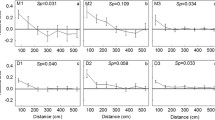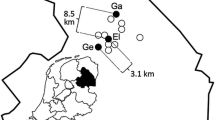Summary
A multilocus procedure was used to estimate outcrossing rates in ten roadside populations of Trifolium hirtum in California. Three groups of populations were studied: cultivars, hermaphroditic, and gynodioecious (sexually dimorphic) populations. The multilocus outcrossing rate (tm) varied from 0.05 to 0.43 among populations. Population level tm estimates were significantly correlated with the observed heterozygosity in gynodioecious populations but not in hermaphroditic populations. The outcrossing rate of hermaphrodites and females was estimated in three gynodioecious populations; the estimates of tm varied from 0.09 to 0.23 for hermaphrodites and from 0.73 to 0.80 for females. The distribution of outcrossing rates in gynodioecious populations is bimodal. Our results indicate that for the levels of selfing observed among hermaphrodites, inbreeding depression is likely to be a major factor in the maintenance of females in gynodioecious populations.
Similar content being viewed by others
References
Barrett SCH, Eckert CG (1990) Variation and evolution of mating systems in seed plants. In: Kawano S (ed) Biological approaches and evolutionary trends in plants. Academic Press, London New York, pp 229–254
Brown AHD (1979) Enzyme polymorphism in plant populations. Theor Popul Biol 15:1–42
Brown AHD, Allard RW (1970) Estimation of the mating system in open-pollinated maize populations using isozyme polymorphisms. Genetics 66:133–145
Brown AHD, Marshall DR, Albrecht L (1974) The maintenance of alcohol dehydrogenase polymorphism in Bromus mollis L. Aust J Biol Sci 27:545–559
Brown AHD, Zohary D, Nevo E (1978) Outcrossing rates and heterozygosity in natural populations of Hordeum spontaneum Koch in Israel. Heredity 41:49–62
Charlesworth B, Charlesworth D (1978) A model for the evolution of dioecy and gynodioecy. Am Nat 112:975–997
Charlesworth D (1981) A further study of the problem of the maintenance of females in gynodioecious species. Heredity 46:27–39
Charlesworth D (1989) The population biology of gynodioecy in Silene vulgaris. Am J Bot [Suppl] 76:74
Ennos RA, Clegg MT (1982) Effect of population substructuring on estimates of outcrossing rate in plant populations. Heredity 48:283–292
Frank SA (1989) The evolutionary dynamics of cytoplasmic male sterility. Am Nat 133:345–376
Glover DE, Barrett SCH (1987) Genetic variation in continental and island populations of Eichhornia paniculata (Pontederiaceae). Heredity 59:7–17
Gregorius HR, Ross MD, Gillet E (1982) Selection in plant populations of effectively infinite size: III. The maintenance of females among hermaphrodites for a biallelic model. Heredity 48:329–343
Harding J, Mankinen CB, Elliot MH (1974) Genetics of Lupinus VII. Outcrossing, autofertility and variability in natural populations of the nanus group. Taxon 23:729–738
Hedrick PW, Ritland K (1990) Gametic disequilibrium and multilocus estimation of selfing rates. Heredity 65:343–347
Holtsford TP, Ellstrand NC (1989) Variation in outcrossing rate and population genetic structure of Clarkia tembloriensis (Onagraceae). Theor Appl Genet 78:480–488
Kesseli R, Jain SK (1984) An ecological genetic study of gynodioecy in Limnanthes douglassi (Limnanthaceae). Am J Bot 71:775–786
Jain SK (1975) Population structure and the effects of breeding systems. In: Frankel OH, Hawkes JG (eds) Crop genetic resources for today and tomorrow. Cambridge University Press, London, pp 15–36
Jain SK, Martins PS (1979) Ecological genetics of the colonizing ability of rose clover (Trifolium hirtum All). Am J Bot 66:361–366
Jain SK, Suneson CA (1964) Population studies in predominantly self-pollinated species. VII. Survival of a male-sterility gene in relation to heterozygosis in barley populations. Genetics 50:905–913
Love RM (1985) Rose clover. In: Taylor NL (ed) Clover science and technology. American Society of Agronomy Monograph No 25. Madison, Wis., pp 535–546
Ritland K (1988) The genetic-mating structure of subdivided populations II. Correlated mating models. Theor Popul Biol 34:320–346
Ritland K (1990) A series of fortran computer programs for estimating plant mating systems. J Hered 81:235–237
Ritland K, Jain SK (1981) A model for the estimation of out crossing rate and gene frequencies using n independent loci. Heredity 47:35–52
Ross MD, Gregorius HR (1985) Selection with gene-cytoplasm interactions. II. Maintenance of gynodioecy. Genetics 109:427–439
Ross MD, Weir BS (1975) Maintenance of male sterility in plant populations III. Mixed selfing and random mating. Heredity 35:21–29
Sun M, Ganders FR (1988) Mixed mating systems in Hawaiian Bidens (Asteraceae). Evolution 42: 516–527
Valdeyron G, Dommee B, Vernet Ph (1977) Self-fertilization in male fertile plants of a gynodioecious species: Thymus vulgaris L. Heredity 39:243–249
Wolff K, Friso B, van Damme JMM (1988) Outcrossing rates and male sterility in natural populations of Plantago coronopus. Theor Appl Genet 76:190–196
Author information
Authors and Affiliations
Additional information
Communicated by P. M. A. Tigerstedt
Rights and permissions
About this article
Cite this article
Molina-Freaner, F., Jain, S.K. Breeding systems of hermaphroditic and gynodioecious populations of the colonizing species Trifolium hirtum All. in California. Theoret. Appl. Genetics 84, 155–160 (1992). https://doi.org/10.1007/BF00223995
Received:
Accepted:
Issue Date:
DOI: https://doi.org/10.1007/BF00223995




